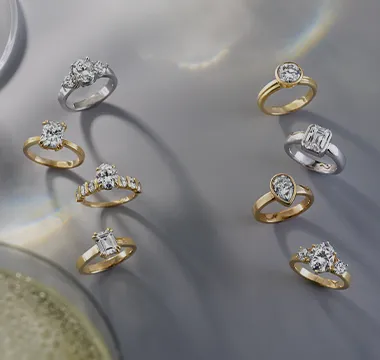
What Are Lab-Grown Diamonds?
Lab-grown diamonds (also known as lab-created diamonds, man-made diamonds, engineered diamonds, and cultured diamonds) are grown in highly controlled laboratory environments using advanced technological processes that duplicate the conditions under which diamonds naturally develop when they form in the mantle, beneath the Earth’s crust. These lab-created diamonds consist of actual carbon atoms arranged in the characteristic diamond crystal structure. Since they are made of the same material as natural diamonds, they exhibit the same optical and chemical properties.
There are two primary methods of producing lab diamonds:
- High-Pressure High Temperature (HPHT): This method mimics the conditions under which natural diamonds are formed inside the earth. To produce the lab diamond, a large machine is fed a certain amount of carbon material that it then crushes under pressures of more than 870,000 lbs. per square inch at extreme temperatures ranging from 1300 – 1600 degrees Celsius.
- Chemical Vapor Deposition (CVD): CVD is when a seed diamond is placed in a small vacuum chamber filled with heated hydrogen and carbon-containing gases. At a certain temperature, the gas molecules are broken down and layers of crystallized carbon begin to form around the seed, growing a more substantial diamond. Some lab diamonds created through CVD may also undergo pressure and heat treatment after they are grown.
You can’t tell the difference between natural diamonds, lab diamonds grown via HPHT method, and lab diamonds grown via CVD method with the naked eye, only scientists can distinguish the differences by analyzing identifying markers caused by the growth conditions.
Lab Grown Diamonds vs. Moissanites vs. Cubic Zirconia
It is important to note the major distinction between lab-grown diamonds and diamond simulants. Lab diamonds are created from carbon, just like real diamonds. Diamond simulants look similar to diamonds but are not created with true carbon crystals.
Two of the most common diamond simulants are moissanite and cubic zirconia.
- Moissanite: While natural moissanite does occur, it is very rare. That is because it is not from Earth – it comes from space in meteorites. Thus, the moissanite that you can purchase is also lab-created. Though they can look very similar to a diamond, they often feature more of a rainbow glint than the bright sparkle of a traditional diamond.
- Cubic Zirconia: Cubic zirconia (CZ) is another synthetic crystal sometimes used in place of diamonds. While it has a reasonable amount of durability and sparkle, it does not match the brilliance of diamonds and will show some wear and tear over time. It is sometimes used as a placeholder in jewelry until a stronger stone can be added.
So cubic zirconia and moissanite aren’t diamonds of any kind, though they can look very similar.
Simulants do not have the same chemical and physical properties as natural diamonds and therefore sell at much lower prices than lab-created diamonds. Simulants can be distinguished from natural, or lab-created diamonds using only the naked eye.
Natural and lab-created diamonds have thermal conductivity properties that differentiate them from cubic zirconia with a handheld diamond tester. Some lab-created diamonds, along with some natural colored diamonds, may be mistakenly identified as moissanites when using certain diamond testers due to similarity in their electrical conductivity. However, gemologists can typically distinguish between diamond and moissanite due to their differing refractive properties, with moissanite being double refractive and diamonds being single refractive.
Pros & Cons of Lab-Created Diamonds
The Pros
- You’ll get a bigger diamond for the same budget. Lab-grown diamonds are less expensive than natural diamonds for the same quality.
- Lab-made diamonds will look the exact same – because they are chemically, physically, and optically the same. The only difference is their origin, and one cannot know where a diamond is from unless they use advanced equipment to test it.
- Lab-grown diamonds are viewed as more sustainable and eco-friendly, as they don’t require mining.
- Lab-grown diamonds are conflict-free by definition
The Cons
- Lab-grown diamond’s resale value is more uncertain – so if that matters, you may want to go with a natural diamond. Natural diamonds have been around for decades and have largely held value. However, over the last few years, the retail and resell price of natural diamonds has been dropping.
- Even though lab and natural diamonds are chemically the same, the “natural” origin of a diamond might matter to some people.


